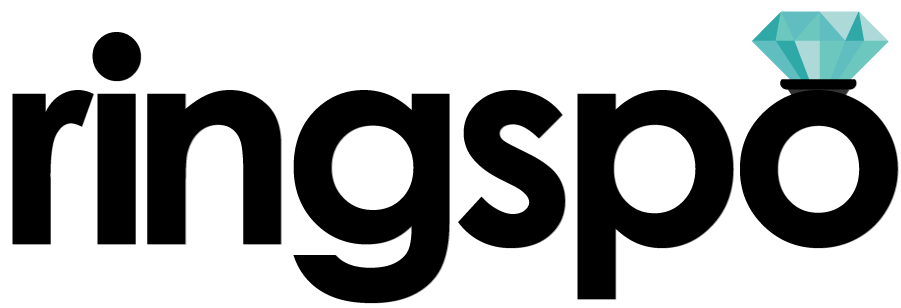Ruby Engagement Rings
Ultimate guide to buying a ruby ring
Ringspo is reader supported
Ringspo is reader-supported, which means we may receive a commission if you click a link to a retailer & subsequently make a purchase.
We feature links to several retailers to help readers find the one that is the best fit for them. Find out more about how Ringspo works here.
Ruby engagement rings can be a great alternative to diamonds and are growing in popularity as people look for a more unique ring. As well as being a beautiful stone, they are also durable enough to stand up to the day to day use and abuse that engagement rings find themselves subject to.
In this guide I’m going to look at everything that you really need to know about buying a ruby engagement ring. Sure, there is other information that I could include, there are whole books on the subject and people dedicate their careers to being ruby experts, but if it’s not going to help you to get an incredible ring then I’m not going to include it.
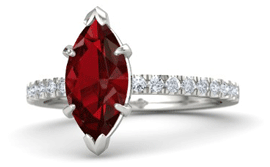
What are rubies?
Rubies are actually the same stone as sapphires – a mineral called ‘corundum’ which is found in all over the world. All red corundum is classified as ruby while the other colors (blue yellow, purple, green, orange and more) are called sapphires.

High quality rubies are actually much rarer than diamonds and, unlike diamonds, their supply has never been artificially restricted because they’re already so scarce. As a result, rubies are often more expensive than diamonds of the same size.
Rubies were originally mainly mined in Myanmar (Burma), but now very few high quality rubies are found there. Rubies are now mainly mined in Thailand, Cambodia, Tanzania and several other countries around the world.
Moh Money, Mo’ Problems?
Gemstones (in fact, all materials) are measured on a scale of hardness, called ‘Moh’s scale’ with a perfect 10 being a diamond. Diamonds are the hardest material out there – the Under Siege-era Steven Seagal of the precious gem world.
Rubies score a 9 on Moh’s scale, which is a solid result and puts them up there with the hardest gemstones. However, engagement ring is usually worn every day and will inevitably suffer a few bumps and knocks. Although rubies are pretty hardy, they can still be damaged if they take too much of a pummelling.
So, you’ll need to have a think about the person who is going to be wearing the ring. If she is the very picture of feminine grace (I’m sure she is!), then you may be able to get away with it. However, if she has an active job, or is likely to suffer the odd drunken tumble out of a taxi, then you should look for a ring setting that doesn’t put the ruby high up and exposed where it could possibly be damaged.
Ruby buying guide
I’ll also talk about what settings are suitable for ruby engagement rings, but choosing the setting that is right for your intended is really down to personal preference and what you think is going to knock her socks off.
All precious stones are ranked using a system known as ‘the 4 Cs’. You might have heard of it, but basically it covers:
- Color
- Cut
- Clarity
- Carat
With diamonds, all 4 of the Cs need to be taken into account in roughly equal measure when you’re choosing a rock. But with a ruby, there is one C that rules them all – color. So I should probably start with that one
Ruby Color
With rubies, the intensity of the red is the main factor that affects how desirable it is and therefore how much it is going to cost. A good ruby is an intense, rich crimson, without being too light or dark. The slightly morbid phrase that is often used to describe the ideal color is ‘pigeon’s blood’. Just in case you don’t have any pigeons nearby to check the color of their blood, I’ve included a handy color grading diagram below. The colour grading goes from A to AA to AAA to Gem, with Gem being the best.
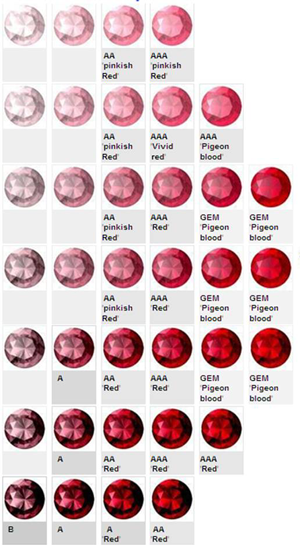
Towards the top left of the chart you can see some very light rubies, and these lighter stones are sometimes called ‘pink sapphires’ as the line between the a light ruby and a pink sapphire is unclear. In fact there’s an old jeweller’s joke: “Whether it’s a ruby or a pink sapphire depends on whether you’re the buyer or the seller.”
OK, maybe not ROFL-worthy, but it’s worth bearing in mind that with all precious gems, jewelers aren’t above trying to pull the wool over buyers’ eyes.
There are actually three factors that need to be considered when judging a ruby’s color:
- Hue relates to where on the spectrum of red the ruby’s color sits – the ideal is a bright red.
- Tone relates to the depth of the color ie. how light or dark it is, and how evenly the color is distributed over the stone.
- Saturation is the purity of the color, with the highest quality rubies classified as ‘vivid’, and the scale then introducing brown and grey at the other end. Basically aim for either vivid or moderately red and avoid anything with a mention of brown or grey in the color.
To properly gauge the color of a ruby, it’s best to look in daylight, rather than the harsh lights of shops. Fluorescent tubes have no output in the red end of the spectrum, which can make rubies look duller and greyer than they really are.
Ruby Clarity
The clarity of a stone depends on two factors, and it’s basically a judgement on how well the stone was formed. The two factors are:
- Inclusions or flaws
- Transparency
Inclusions in rubies
There is no such thing as a flawless ruby – all rubies will have some sort of natural inclusions, and they can usually be seen with the naked eye. The ‘flaws’ are caused my other minerals that are present when the ruby was originally formed.
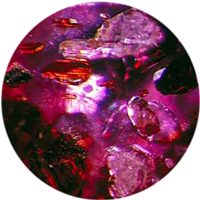
In fact, if someone is offering you a ‘flawless ruby’, then it’s almost definitely fake and you should turn around and head on out of there.
However, although flaws are part and parcel of buying a ruby, not all are equal and you need to know what to look out for.
The most severe flaws, and something that you should avoid, are cracks along the surface, which can seriously impact the stone’s strength and mean that it could break along the crack. Avoid. The other type are internal inclusions like the crystals on the right, and the main thing to watch out for is that they aren’t too obvious and that they don’t make the color of the ruby inconsistent or affect the transparency of the stone
Ruby Transparency
Rubies should be semi-transparent, which means that you should be able to see through them, but you can’t expect them to be totally see through like glass. A good way to test transparency is to see whether you can read text that is placed behind it. It will be tough, but you should be able to just make it out.
Transparency is graded as:
- Transparent: ruby will transmit light without serious dispersion
- Translucent: allows light to pass through, but not transparent
- Opaque: does not allow light to pass through.
Treatments and Enhancements in rubies
Despite inclusions being an accepted part of every ruby, jewelers do their best to minimise their visibility as much as they can, which will improve the stone’s appearance and its value.
There are several treatments that are applied to rubies to enhance their color, and all should be clearly marked on the certification of the stone you are looking to buy. Some of the treatments can affect the durability of the ruby, so you need to make sure you know what you’re buying
It is possible to buy untreated rubies, but any untreated ruby with good color is likely to be very expensive indeed. If this is what you’re looking for, then make sure that you have an independent certification conducted to verify that the stone is what it says it is.
Heat treatment in rubies:
- A very common treatment is to heat the ruby to nearly melting point (around 1600c), which cause the inclusions to reform and improves the color by making it more vivid.
- It’s safe to assume that any ruby that you will buy has been heat treated, and it’s often seen as a continuation of the natural processes that formed the ruby, so it doesn’t affect the durability or the price of the stone much.
- Heat treatments will be labelled as E or H on the ruby’s certification.
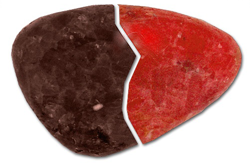
Diffusion treatment in rubies
- Diffusion involves applying chemicals to the surface of the stone and then heating it to improve the color
- Any change is only at the surface level – down to about half a millimetre. If any damage occurs to the stone or if it is recut then the original, less desirable color will be visible
- Stones treated by diffusion will be marked U and are worth much less than those that have not received this treatment
Filling treatment in rubies
- Filling involves filling the internal fractures of the ruby with lead crystal glass, and then heating it, which can make an opaque stone much more transparent.
- Filling is frowned upon because of the toxicity of lead and because heat and ultra-sonic cleaning methods can reverse the treatment
- Filling should be marked on the certification as F and the treatment should reduce the price of the ruby considerably.
Irradiation treatment in rubies
- Irradiation involves exposing rubies to beryllium, rubies change color to a brighter hue of red.
- However, this wears off extremely quickly in sunlight and the ruby will soon return to its natural, duller color.
- Irradiated rubies should be labelled R on their certification and again, a ruby that has received this treatment is worth much less than one without
Ask the seller about any type of enhancements the ruby in the ring has undergone and ensure that there is a solid return policy in case the stone is not what you were originally sold.
Ruby cut
‘Cut’ is a grading of how well a stone has been turned from a rough and nobbly rock, freshly dug out of the ground, into a sparkling gemstone. And while ‘cut’ is the most important factor when choosing a diamond as it is the biggest factor in determining how much a diamond sparkles, with rubies it takes a backseat behind color and clarity.
Slightly confusingly, ‘cut’ can also be used to describe the shape of a stone. There are some shapes which are more common than others, but ultimately it should just be about finding a shape that you like.


The most common cuts for rubies are the classics – ovals or cushions. These have a large, flat area at the top of the stone, making it appear as large as possible, and also result in minimum wastage when the stone is being cut which keeps the cost down.
Round stones are also a popular choice, but due to the higher proportion of the rough stone that hits the cutting room floor as the edges are smoothed off, round rubies command a slight premium.
Rubies and carat weight
The size of a ruby us either measured in mm or in carats, with a diameter in mm often used for stones smaller than 0.5 carats, and the carat scale used above that.
One thing to note is that rubies are dense and heavy compared to other gemstones. This means that a ruby that weighs 1 carat will be smaller than a diamond that weighs the same amount.
When you’re comparing different rubies, make sure that you ask the jeweler what the ‘price per carat’ is for each stone. This will allow you to see how the more important factors like color are affecting the price, without the difference in size getting thrown into the mix and confusing you.
Rubies and overall quality grades
Those are the Four Cs of rubies, but unlike in diamonds which are relatively easy to grade consistently, rubies are much more difficult. Rubies are therefore given an overall grade to make it easier for consumers to understand what they’re getting.
Gem Quality Rubies
Gem quality are the very top quality of ruby, and not available at all retailers. With perfect color and excellent clarity they will make excellent center stones for engagement rings, but are priced accordingly.
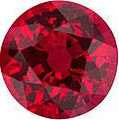
AAA Quality Rubies
Triple A gemstones are the top 10% of rubies in terms of quality. They usually have the rich red ‘pigeon blood’ color, and are slightly included. AAA is the highest grade that most jewelers offer.

AA Quality Rubies
AA are the top 20%-30% of gemstones. They are usually medium dark red and very slightly included. They are less suitable for the center stones of rings, but work well as smaller supporting stones.

A Quality Rubies
‘A’ grade rubies are a light or medium red color, are less translucent and have more obvious inclusions that can be easily seen with the naked eye. The price shold be much lower and I wouldn’t recommend for a large center stone of an engagement ring.
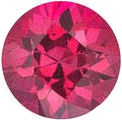
B Quality Rubies
B stones are darker and more opaque still and have more obvious inclusions. They are more suitable for smaller gemstones in jewelry, like the channel stones in a channel engagement ring setting.

Ruby Certification
A gemstone grading report, or ‘certification’, is a piece of paper to say that the stone has been examined and graded, usually by an independent authority. For those buying a diamond, it’s an essential part of the purchase: it lets them know that what they are buying is the quality that they are paying for.

Ideally it’s an independent lab like Gemological Institute of America (GIA) or American Gem Trade Association (AGTA) that you should be looking for. However, with some retailers you may need to accept the grade that has been given to a stone by the retailer themselves, following an assessment by their in-house gemologists.
As well as listing the size, shape, color and transparency of a stone, a grading report should also list any treatments that have been applied to the stone. One thing that a grading report doesn’t include is a value – that is dependent on the market conditions at the time. A similar report that is conducted to ascertain the value of a stone or of an engagement ring is known as an ‘appraisal’, which are often conducted for insurance purposes.
The big advantage of independent certification is that they will ensure that you are getting the real deal – a genuine ruby. Some unscrupuluous dealers will try and pass off less valuable red gems by giving them a name that includes ‘ruby’ with Ruby e.g.
- Adelaide Ruby
- American Ruby
- Australian Ruby
- Bohemian Ruby
- Cape Ruby
- Rocky Mountain Ruby
Generally speaking, any time the word Ruby is used with a prefix it is an imitation or a less valuable red gemstone. With rubies though, it’s not always possible to ensure that your stone has been graded by an independent authority as not all jewelers and retailers accept the grading system.
Ruby engagement ring settings
Getting the center stone right is a big factor in choosing your engagement ring, but the ring setting style is almost more important in deciding what the ring actually looks like. I’ve included a small selection of ring setting styles in this section, but each retailer offers many more variations. Each of these styles can also be purchase in yellow gold or rose gold too. Click through to each to find out more or to dial them in to your specifications.
This simple pavé solitaire ruby engagement ring allows the center stone to take center stage without any distractions.
Oval ruby engagement ring with pavé ring band
Check out all ruby rings at Gemvara

Side stones are another good way to add extra impressiveness to a ruby engagement ring. This oval ruby is flanked by two trilliant cut white sapphires with a total weight of over 1 carat.
Oval ruby engagement ring with trilliant diamond side stones
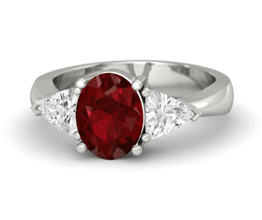
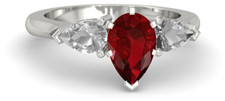
Less common stone shapes can also work extremely well as center and side stones. This three stone ring features elegant pear-shaped stones, which can have a flattering slimming effect on fingers.

If you want to dial up the romance then what could be more romantic than a ruby red heart? Although this shape might not be the one for you, Gemvara has a huge range of rings with every shape of ruby – click through to check them all out.
Halo rings can be as blingy and impressive as you can imagine. This double halo with pavé split shank band will catch the light and sparkle from any direction, while retaining a sense of understated class with the ruby center stone.


This ring is a recreation in ruby of the sapphire ring that Prince William gave to Princess Kate. The ring is named the ‘Diana’ as the Princess Kate’s ring was originally owned by Prince William’s mother, Diana Princess of Wales.
